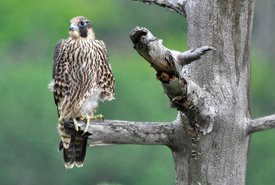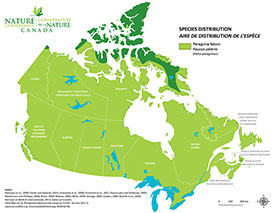
Peregrine falcon (Photo by Jean-François Plouffe)
Peregrine falcon
Gaze skyward on a clear day and you might notice a crow-sized, hawk-like silhouette on the edge of a high-rise or cliff. You might be looking at a peregrine falcon.
If you’re lucky, you may even witness one of these masters of stealth perform an aerial hunting dive — the stoop. Interactions between humans and peregrine falcons go back thousands of years. A favourite of nomadic falconers in central Asia, the peregrine has extremely acute eyesight in low light, making it an effective game hunter even at dawn and dusk.
What does the peregrine falcon look like?
Peregrines are distinguishable from other raptors by their blue-gray back with barred underparts and slate-coloured face markings, including “sideburns.” Adult males measure 36 to 49 centimetres long, weighing 650 grams, while females are generally larger measuring 45 to 58 centimetres in body length and and 950 grams in weight.
Known for their speed, the species’ compact plumage, long, pointed wings and long tail give them a streamlined build. The peregrine falcon can cruise between 40 to 55 kilometres per hour and can top speeds at 112 kilometres per hour during pursuit of prey. They can get up to more than 320 kilometres per hour when stooping.
Where does the peregrine falcon live?
The name peregrine is derived from the Latin adjective peregrinus, meaning “wanderer.” The peregrine falcon is a wide-ranging species found on all continents except for Antarctica. Three of the 22 subspecies worldwide are found in North America.
The pealei subspecies can be found in British Columbia and parts of Alaska. Peregrines in those areas are residents or slight migrants. The tundrius subspecies are highly migratory birds in the High Arctic, while the anatum subspecies nests south of the treeline. Birds banded in the Northwest Territories have been recorded in Argentina!
Peregrines truly live the high life. They are usually found in open habitats with tall structures. Due to the similarity of the stark concrete of buildings to cliffs in the wild, peregrines can be found living on skyscraper ledges, quarries, transmission towers and even silos. Some nests can be found more than 3,600 metres high.
During migration, these raptors can be found at barrier islands, mudflats, coastlines, lake edges and mountains.
What is the peregrine falcon's conservation status?
Peregrine falcons, along with many birds of prey, fell victim to the toxic effects of DDT between 1950 and 1970 when the chemical was widely used. Peregrine falcon populations were decimated. A decisive move to ban DDT in the early 1970s in Canada and the U.S., along with efforts such as captive breeding and release programs, were the first steps in the species’ recovery.
The Committee on the Status of Endangered Wildlife in Canada has assessed the pealei subspecies found on the Pacific coast as special concern, with the anatum/tundrius subspecies is assessed as not at risk. The continued use of pesticides in the subspecies’ wintering grounds, as well as yet unknown effects of new pesticides licensed in Canada, are of concern. Other threats include habitat degradation and fragmentation, human interference and poaching. The Canadian peregrine population is showing an increasing trend and currently estimated at more than 5,000 individuals.
What is NCC doing to protect the peregrine falcon's habitat?
The Nature Conservancy of Canada (NCC) is working to protect critical peregrine falcon habitats, such as the escarpments at the Alfred-Kelly Nature Reserve in Quebec, to ensure the birds are undisturbed by the many hikers who enjoy the reserve.
Thanks to Vigie faucon, a group of volunteer birdwatchers, NCC has developed a yearly monitoring program to assess the reproduction success of the peregrine falcon. At least one breeding pair has been found in the Alfred-Kelly Nature Reserve and the couple produced three chicks in 2015.
From 2014 to 2015, NCC and its partners rerouted two trails here to minimize disturbance to nesting falcons. Efforts were also directed at raising the public’s awareness about the reserve’s conservation status. A team of stewardship agents was put in place, and interpretive panels are presently being created. NCC has involved partner organizations towards the creation of a five-year masterplan that will aim at better protecting the peregrine falcon and natural habitats at large.






